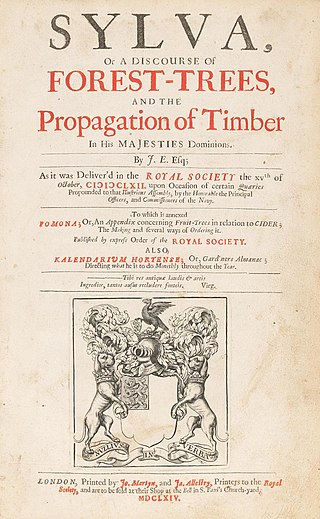
The Royal Horticultural Society (RHS), founded in 1804 as the Horticultural Society of London, is the UK's leading gardening charity.

John Evelyn was an English writer, landowner, gardener, courtier and minor government official, who is now best known as a diarist. He was a founding Fellow of the Royal Society.

Horticulture is the cultivation of plants in gardens or greenhouses, as opposed to the field-scale production of crops characteristic of agriculture. It includes the cultivation of fruits, vegetables, nuts, seeds, herbs, sprouts, mushrooms, algae, flowers, seaweeds and non-food crops such as grass and ornamental trees and plants. It also includes plant conservation, landscape restoration, landscape and garden design, construction, and maintenance, and arboriculture, ornamental trees and lawns.

The quince is the sole member of the genus Cydonia in the Malinae subtribe of the Rosaceae family. It is a deciduous tree that bears hard, aromatic bright golden-yellow pome fruit, similar in appearance to a pear. Ripe quince fruits are hard, tart, and astringent. They are eaten raw or processed into marmalade, jam, paste or alcoholic beverages.

John Lindley FRS was an English botanist, gardener and orchidologist.

Malus domestica is a cultivar of apple that is usually eaten cooked due to its sourness. The variety comes from a pip planted by Mary Ann Brailsford. The Concise Household Encyclopedia states, "Some people eat this apple raw in order to cleanse the palate, but Bramley's seedling is essentially the fruit for tart, pie, or dumpling." Once cooked, however, it has a lighter flavour. A peculiarity of the variety is that when cooked it becomes golden and fluffy.
The Victoria Medal of Honour (VMH) is awarded to British horticulturists resident in the United Kingdom whom the Royal Horticultural Society Council considers deserving of special honour by the Society.

Garden tourism is a type of niche tourism involving visits to famous gardens and botanical gardens and places which are significant in the history of gardening. Garden tourists often travel individually in countries with which they are familiar but often prefer to join organized garden tours in countries where they might experience difficulties with language, travel or finding accommodation in the vicinity of the garden. In the year 2000 the Alhambra and the Taj Mahal both received over two million visitors. This poses problems for the landscape manager.

Sylva, or A Discourse of Forest-Trees and the Propagation of Timber in His Majesty's Dominions by the English writer John Evelyn was first presented in 1662 as a paper to the Royal Society. It was published as a book two years later in 1664, and is recognised as one of the most influential texts on forestry ever published.

Sayes Court was a manor house and garden in Deptford, in the London Borough of Lewisham on the Thames Path and in the former parish of St Nicholas. Sayes Court once attracted throngs to visit its celebrated garden created by the seventeenth century diarist John Evelyn. Now completely buried beneath Convoys Wharf and Sayes Court Park, the area shows little sign of its former glory, despite having been a key factor in the creation of the National Trust.
Valerie Finnis (1924–2006) was a well-known British photographer, lecturer, teacher and gardener.
John Beale was an English clergyman, scientific writer, and early Fellow of the Royal Society. He contributed to John Evelyn's Sylva, or A Discourse of Forest-Trees and the Propagation of Timber, and was an influential author on orchards and cider. He was also a member of the Hartlib Circle.

Dr Gabriel Hemery is an English forest scientist (silvologist) and author. He co-founded the Sylva Foundation with Sir Martin Wood, a tree and forestry charity established in 2009.
Donald Wyman was an American horticulturist, the head of horticulture at Harvard University's Arnold Arboretum from 1935 to 1970.
Sarah Simblet is a graphic artist, writer and broadcaster, who teaches anatomical drawing at the Ruskin School of Drawing and Fine Art and at the University of Oxford.

The Orchid Review, published quarterly by the Royal Horticultural Society, is a magazine 'dedicated to the celebration and deeper understanding of orchids'. It is the world's oldest existing periodical devoted to orchids and each issue features articles by internationally acclaimed experts on subjects such as cultivation, in-depth plant profiles, historical investigation, orchid exploration and all the latest from the world of orchid growing and showing.
Scott Zona is an American botanist. From 1993 to 2008, he was the Palm Biologist at Fairchild Tropical Botanic Garden. From 2008 to 2017, he served as the curator for the Florida International University Wertheim Conservatory. He is noted for his study of palms and is co-editor for Palms, the journal of the International Palm Society.
Evelyn Mary Booth (1897–1988) was an Irish botanist, designer of the gardens at Lucy's Wood, and writer of The Flora of County Carlow. She was described as "one of Ireland's most loved and respected botanists".

Writing about gardens takes a variety of literary forms, ranging from instructional manuals on horticulture and garden design, to essays on gardening, to novels. Garden writing has been published in English since at least the 16th century.
Margaret Jane ("Jean") Foweraker née Willis was a New Zealand botanist who specialised in alpine plants- with a particular interest in alpine varieties of crocus- and was a key figure in their popularisation in New Zealand. She was the primary contributor of alpine plants to Christchurch Botanic Gardens, who renamed their Alpine House in recognition of her. She was also author of a series of genealogical works.











